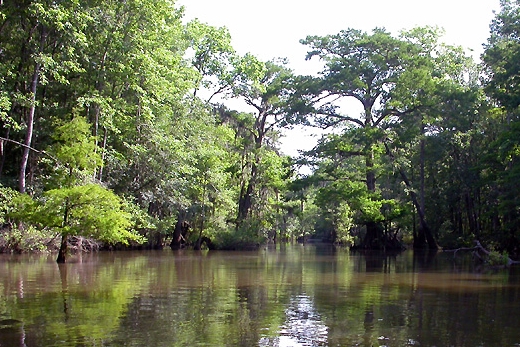- Bottle Creek Indian Mounds
Infobox_nrhp | name =Bottle Creek Site
nrhp_type =nhl

caption = The approach to Mound Island, site is on the left.
nearest_city=Stockton, Alabama
lat_degrees = 30 | lat_minutes = 59 | lat_seconds = 44 | lat_direction = N
long_degrees = 87 | long_minutes = 56 | long_seconds = 15.5 | long_direction = W
locmapin = Alabama
area =
architect=
architecture=
designated=April 19 ,1994 cite web|url=http://tps.cr.nps.gov/nhl/detail.cfm?ResourceId=1420&ResourceType=Site
title=Bottle Creek Site |accessdate=2007-10-13|work=National Historic Landmark summary listing|publisher=National Park Service]
added =December 02 ,1974 cite web|url=http://www.nr.nps.gov/|title=National Register Information System|date=2007-01-23|work=National Register of Historic Places|publisher=National Park Service]
governing_body = Alabama Historical
Commission
refnum=74000398Bottle Creek Indian Mounds is an archaeological site within the Mobile-Tensaw River delta near Mobile,
Alabama ,United States . It was occupied by aMississippian culture and is important to understanding the history and culture of the Mobile-Tensaw delta in late prehistoric times.History
The site was occupied between AD 1250 and 1550, and served as the focal point for interaction with other Mississippian culture areas along the coast and the interior of the
Southeastern United States . It is located on Mound Island in the Mobile-Tensaw River delta and includes 18 earthen mounds, the tallest being roughly 45 feet high. It was the largest Mississippian chiefdom on the north-centralGulf Coast . Scholars believe that it functioned as a social, political, religious, and trade center for the Mobile Delta region and the central Gulf Coast.Bottle Creek site was first mapped in the 1880s, but its location in middle of the delta, completely surrounded by swamp, made it inaccessible and protected it from most of the plunder experienced by similar sites in the Southeast. It was first professionally investigated in 1932 when David L. DeJarnette of the Alabama Museum of Natural History began his work there to determine if the site had a cultural relationship with Moundville, connected to the north by a river system.
It was listed on the
National Register of Historic Places in 1974. It was declared aNational Historic Landmark in 1994.ee also
*
List of National Historic Landmarks in Alabama References
External links
* [http://www.usouthal.edu/archaeology/bc-bottle_creek.htm University of South Alabama Archaeology - Bottle Creek]
Wikimedia Foundation. 2010.
